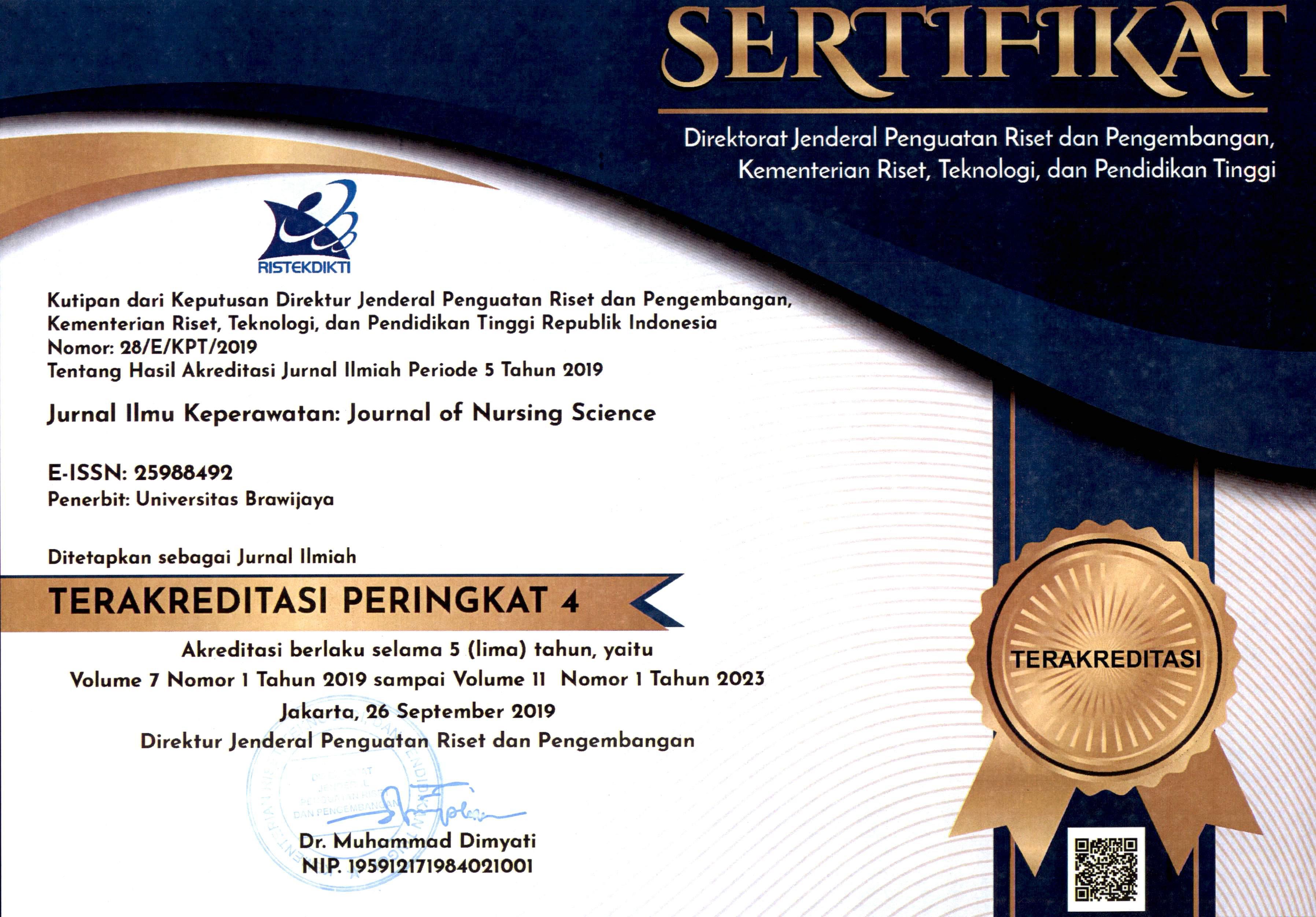INFLUENCE OF INTERACTIVE MULTIMEDIA LEARNING TO NURSING UNDERGRADUATE STUDENTS’ KNOWLEDGE GAIN AND RETENTION ABOUT MENTAL STATUS EXAMINATION
DOI:
https://doi.org/10.21776/ub.jik.2019.007.01.5Keywords:
Interactive multimedia, knowledge gain, mental status examination, nursingAbstract
Mental status examination is a significant phase in delivering nursing care as the basis to make diagnosis. In the reality, a lot of nursing students still difficult to understand terminologies and structures in mental status assessment. Studies show that interactive multimedia may help students to understand real conditions of the patients which are difficult to visualized. However, in the context of mental status assessment, further research required. The design of the study is quasi experimental including pre and post test with control group. The knowledge score measured using instrument 40 items multiple choice self-developed based on theory and has been content and construct validity with Cronbach’s Alpha 0,94. The result was analyzed by using Mann-Whitney test showed that there was a significant difference mean score of intervention group (65,52 + 6,958) compared with control group (47,22 + 3,773) (p = 0,000). Knowledge retention of intervention group (62,13+6,681) and control group (42,45+3,232).The results of this study indicate there is a significant influence of interactive multimedia learning to improve undergraduate nursing students’ knowledge about mental status examination. It is advisable to Nurse Educator for using interactive multimedia to overcome the difficulties of the students in understanding the concepts of mental status examination.
References
- Badiei, M., Gharib, M., Zolfaghari, M., & Mojtahedzadeh, R. (2016). Comparing nurses knowledge retention following electronic continuous education and educational booklet : a controlled trial study. Medical Journal of the Islamic Republic of Iran, 30(364), 1–7.
- Borhani, F., Vatanparast, M., Zadeh, A. A., Ranjbar, H., & Pour, R. S. (2011). Virtual education effect on cognitive learning and attitude of nursing students towards it. Iranian Journal of Nursing and Midwifery Research, 16(4), 321–324.
- Chandler, P. (2004). The crucial role of cognitive processes in the design of dynamic visualizations. Learning and Instruction, 14, 353-357.
- Davis, B., & Summers, M. (2015). Engineering Leaders Conference 2014 Applying Dale ’ s Cone of Experience to increase learning and retention : A study of student learning in a foundational leadership course. In QScience Proceedings (Engineering Leaders Conference 2014) (pp. 1–7). http://doi.org/10.5339/qproc.2015.elc2014.6
- Ehrenberg, Ronald G.,Brewer, Dominic J.,Gamoran, Adam., & Willms, J. Douglas. (2001). Class Size and Student Achievement. Psychological Science in The Public Interest, 2(1), 1-30.
- Evans, B., Bennett, A., McNamee, M., Mars, K., & Sliney, K. (2008). Interactive Psychiatric Mental Status Exam Tutorial (Out of Print). MedEdPORTAL Publication, 4, 1680. http://doi.org/10.15766/mep_2374-8265.1680
- Felder, Richard M. (2005). Understanding Student Differences. Journal of Engineering Education, 94(1), 57-72.
- Finney, G. R., Minagar, A., & Heilman, K. M. (2016). Assessment of Mental Status. Neuroglogic Clinics, 34(1), 1–16. http://dx.doi.org/10.1016/j.ncl.2015.08.001
- Goh, Y., Couns, S. S., Chng, M.-L., & Yobas, P. (2016).
- Nurse Education Today Using standardized patients in enhancing undergraduate students â€TM learning experience in mental health nursing. Nurse Education Today, 45, 167–172. http://doi.org/10.1016/j.nedt.2016.08.005
- Harandi, S. R. (2015). Effects of e-learning on students motivation. Procedia - Social and Behavioral Sciences, 181, 423–430. http://doi.org/10.1016/j.sbspro.2015.04.905
- Hegarty, M., Kriz, S., & Cate, C. (2003). The roles of mental animations and
- external animations in understanding mechanical systems. Cognition and
- Instruction, 21(4), 325–360.
- Hwang, S. Y., & Kim, M. J. (2006). A comparison of problem-based learning and lecture-based learning in an adult health nursing course. Nurse Education Today, 26, 315–321. http://doi.org/10.1016/j.nedt.2005.11.002
- Kaplan, & Sadock’s. (2009). Kaplan & Sadock’s Comprehensive Textbook of Psychiatry, 9th Edition. Lippincott Williams & Wilkins.
- Kassim, H. (2013). The relationship between learning styles , creative thinking performance and multimedia learning materials. Procedia - Social and Behavioral Sciences, 97, 229–237. http://doi.org/10.1016/j.sbspro.2013.10.227
- Kohpaye, J., Esfehani, Z., Mehrabi, H., Ranjbar, H., & Zeighami, S. (2014). The effect of multi-media educational software on learning basic principles of Cardio-Pulmonary Resuscitation ( CPR ) in Nursing Students. Iran J Crit Care Nurs, 7(3), 160–167.
- Kunst, E. L., Mitchell, M., & Johnston, A. N. B. (2016). Manikin Simulation in Mental Health Nursing Education : An Integrative Review. Clinical Simulation in Nursing, 12(11), 484–495. http://doi.org/10.1016/j.ecns.2016.07.010
- Lam, C. C., & Tou, L. U. (2014). Making Education Fun ! The Marketing of Advanced Topics by Multimedia. Procedia - Social and Behavioral Sciences, 148, 79–86. http://doi.org/10.1016/j.sbspro.2014.07.020
- Lehr, S. T., & Kaplan, B. (2013). A Mental Health Simulation Experience for Baccalaureate Student Nurses. Clinical Simulation in Nursing, 9(10), e425–e431. http://doi.org/10.1016/j.ecns.2012.12.003
- Liaw, S. Y., Wong, L. F., Chan, S. W., Tze, J., Ho, Y., Zubaidah, S., … Ang, K. (2015). Designing and Evaluating an Interactive Multimedia Web-Based Simulation for Developing Nurses ’ Competencies in Acute Nursing Care : Randomized Controlled. Journal of Medical Internet Research, 17(1), 1–10. http://doi.org/10.2196/jmir.3853
- Liaw, S. Y., Wong, L. F., Chan, S. W., Tze, J., Ho, Y., Zubaidah, S., … Ang, K. (2015). Designing and Evaluating an Interactive Multimedia Web-Based Simulation for Developing Nurses ’ Competencies in Acute Nursing Care : Randomized Controlled. Journal of Medical Internet Research, 17(1), 1–10. http://doi.org/10.2196/jmir.3853
- Mayer, R. E. (2005). Cognitive theory of multimedia learning. In R.E. Mayer (Ed.), The Cambridge Handbook of Multimedia Learning. New York: Cambridge University Press.
- Mayer, R. E., & Moreno, R. (2002). Aids to computer-based multimedia learning. Learning and Instruction, 12, 107-119.
- Mayer, R., & Chandler, P. (2001). When Learning Is Just a Click Away : Does Simple User Interaction Foster Deeper Understanding of Multimedia Messages ? Journal of Educational Psychology, 93, 390–397. http://doi.org/10.1037//0022-0663.93.2.390
- Mrunalini, & Chandekar. (2015). Factors Affecting the Teaching-Learning in Nursing Education. American Research Journal of Nursing, 1(4), 11–17.
- Schnotz, W. (2005). An integrated model of text and picture comprehension. In R. E. Mayer (Ed.), The Cambridge handbook of multimedia learning (pp. 49-69). Cambridge: Cambridge University Press.
- Seider, T. (2014). Mental Status Testing. In Referenc Modul in Neuroscience and Biobehavioral Psychology Encyclopedia of The Neurological Sciences (2nd ed., pp. 1095–1098). http://doi.org/10.1016/B978-0-12-385157-4.00429-2
- Shabiralyani, G., Hasan, K. S., Hamad, N., & Iqbal, N. (2015). Impact of Visual Aids in Enhancing the Learning Process Case Research: District Dera Ghazi Khan. Ghulam. Journal of Education and Practice, 6(19), 226–233.
- Xiaowei, Z. H. U. (2015). The Design of Multimedia Interactive Courseware Based on FLASH. In International Conference on Education, Management and Computing Technology (ICEMCT 2015) (pp. 1845–1849). Atlantis Press.
- Yu, C. H., Jannasch-pennell, A., Stay, V., Digangi, S., Kim, C., Long, L., … Freeman, R. (2006). Multi-Sensory Cognitive Learning as Facilitated in a FLASH Tutorial for Item Response Theory. In International Conference on Education and Information Systems, Technologies and Applications, Orlando, FL.
- Zary, N., Johnson, G., Boberg, J., & Fors, U. G. H. (2006).
- Development , implementation and pilot evaluation of a Web-based Virtual Patient Case Simulation environment – Web-SP. BMC Medical Education, 6(10), 1–17. http://doi.org/10.1186/1472-6920-6-10
Downloads
Published
How to Cite
License
Authors published in this journal agree to the following terms:
1. The copyright of the received article shall be assigned to the journal as the publisher of the journal. The intended copyright includes the right to publish the article in various forms (including reprints). The journal maintains the publishing rights to the published articles.
2. Authors may enter into separate additional contractual agreements for the non-exclusive distribution of the published journal version of the work (for example, posting it to an institutional repository or publishing it in a book), with acknowledgment of their initial publication in this journal.
3. Authors are permitted and encouraged to post their work online (e.g. in an Institutional Repository or on their website) before and during the submission process, as this can result in a productive exchange, as well as earlier and larger citations of the published work.
4. Articles and all related material published are distributed under Creative Commons Attribution-NonCommercial 4.0 International License or CC BY-NC 4.0 license.
JNSU is licensed under a Creative Commons Attribution-NonCommercial 4.0 International License or CC BY-NC 4.0 license.




























